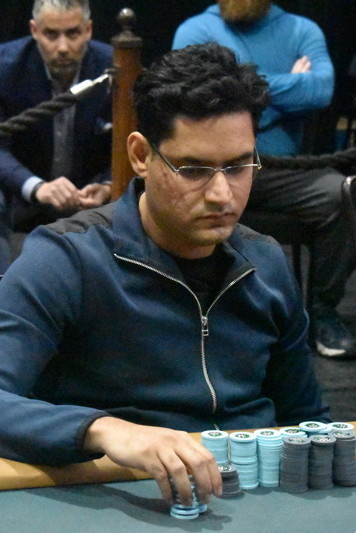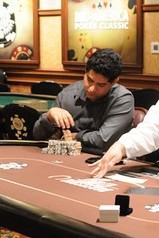






Poker Strategy: Hand Breakdowns With World Series Of Poker Circuit Champ Shiva DudaniChicago-Area Poker Pro Breaks Down Hands From His Second Circuit Title In The Horseshoe Hammond Main Event |
|
|

Shiva Dudani makes his living mostly from playing high-stakes pot-limit Omaha cash games in the Chicago area, but towards the end of 2019, took down one of the larger no-limit hold’em tournaments on the World Series of Poker Circuit.
Dudani, a poker pro of more than a decade, bested a 989-entry field to earn his second WSOP Circuit ring in the Horseshoe Hammond $1,700 no-limit hold’em main event for $258,078. The 34-year-old Mumbai native and Chicago resident earned both of his rings in the state of Indiana as he won his first in the $350 mixed pot-limit Omaha/pot-limit hold’em event at the Horseshoe Southern Indiana stop a decade earlier.
Despite focusing mainly on live cash games, the Iowa State graduate’s most recent score brought his career tournament earnings to just shy of $1 million. Dudani sat down with Card Player to break down a few of the hands he played on the final day of the Horseshoe Hammond main event.
Hand 1
.jpg)
Concepts: Picking good spots as a big stack with the chip leader on your left.
The Action: Shiva Dudani raised to 115,000 from the cutoff and was called by Evan Bethyo in the small blind and Voytek Glab in the big blind. On the flop, action checked to Dudani, who bet 180,000. Bethyo folded and Glab called. On the turn, Glab checked and Dudani bet 380,000. Glab called. On the river, Glab checked, Dudani bet 640,000 and Glab folded.
Steve Schult: Evan Bethyo, who at the time was far and away the chip leader of the tournament, was in the small blind. How did his presence affect your opening range from the cutoff? Would you be tighter than normal in this spot because he was in the blinds?
Shiva Dudani: Being second in chips in the late stages of a tournament can be tricky. Since Evan was the only person that had me covered, I had to make certain adjustments. Additionally, Evan was clearly a fearless player. Given his limited experience, I felt he might overplay a hand rather than pot control it.
That said, I considered the cutoff the best position to open wide, as it was his small blind where he would likely play tight. If Evan was the button or the big blind, I would be less likely to open with a wide range.
SS: Can you elaborate on what you perceive his range to be when he flats from the small blind?
SD: Considering Evan’s chip stack and game flow, I expect Evan to be wider here from the small blind than most other players. I think it is unlike he would trap with a premium hand, and I would expect he could be as wide as small pairs, weak aces or even unsuited one-gappers.
SS: Voytek Glab defends the big blind. Given the price he is getting, is his range wider than if he were the lone caller? What kind of range are you expecting him to have here?
SD: I expect Voytek to defend the big blind with almost all of his hands here.
SS: You take a flop three-handed. In a more general sense, are you forced to play more straightforward in multiway pots? Are there certain board textures that you would be more willing to bet with air three-handed?
SD: This is not a great board to c-bet with air against two sticky opponents, especially with one of them being the chip leader. I would be more likely to c-bet (continuation bet) air on unsuited and unconnected boards that contain an ace or a king.
SS: You flop the second nuts, both players check to you, and you bet about half the size of the pot. I’ve seen some very small sizings post-flop recently. Why did you choose this sizing?

Dudani At The Final Table In Hammond (Photo Credit: WSOP)
SS: Behtyo folds and Glab calls. What are you starting to narrow his range to?
SD: When Glab just calls, I expect him to have a medium-strength hand with some showdown value. A likely hand might be a pair with a weak spade draw. I think it is unlikely he would just call with a made flush or the A , as I would expect him to check-raise with those hands. Since he is defending the big blind quite wide, he could have a hand as weak as 4-5 offsuit.
, as I would expect him to check-raise with those hands. Since he is defending the big blind quite wide, he could have a hand as weak as 4-5 offsuit.
SS: The turn is the A and it is checked to you again. You still have the second nuts, but how does this card affect his hand strength? Would you have chosen a different size on a different non-spade, non-board pairing turn card?
and it is checked to you again. You still have the second nuts, but how does this card affect his hand strength? Would you have chosen a different size on a different non-spade, non-board pairing turn card?
SD: I do have some history playing with Voytek, as he is a Chicago native. I think he perceives me as a good player/pro and is more likely to take a more cautious line. However, I think he may still check-raise the naked As and try to end the hand.
The ace is most likely a bad card as it is a scare card to most of his hands that contain the pair and a weak spade draw. I think I may have gone larger on a more brickish turn.
SS: When you triple barrel this board, it looks pretty strong. What hands are you hoping to get called by on the end?
SD: I’m just hoping to get called by worse flushes, two pair, or even a stubborn top pair on the flop.
Hand 2
.jpg)
Concepts: Trapping preflop with big pairs.
The Action: Firas Sadou raised to 175,000 from middle position and Shiva Dudani called on the button. On the flop, Sadou bet 200,000, Dudani raised to 500,000 and Sadou moved all in for 1,705,000. Dudani called.
SS: Firas Sadou raised from middle position and you just called on the button with pocket kings. How often do you trap with big pairs? Was this a player-specific move?
SD: My decision to trap here is player dependent. I had been three-betting Firas quite a bit preflop and he had been folding. Also, I thought this flat might look weak to the blinds and cause them to squeeze. No matter what I decide, I get to play a hand in position with kings, which is a nice situation.
SS: On a seven-high flop, Sadou continues to bet after raising preflop. It’s obviously a favorable board for your hand, but why raise now instead of continuing to underrepresent your hand? Would you have raised if the flop was rainbow?

Dudani Three-Handed During His First Ring Win In 2010 (Photo Credit: WSOP)
Additionally, I believe he is the type of player to give up with his bluffs on the turn, so I do not gain anything additional by remaining under-repped. Overall, the best way to build the pot seemed to be by raising the flop and putting him to a decision for his stack.
SS: Would you be raising flush draws on this flop? Are those the types of hands that would help you balance your range?
SD: Overall, I believe balance is overrated in tournaments such as these. Since I will not be playing frequently with the players or find myself in these specific spots very often, I believe I should just play each hand in the most profitable way, not considering balance.
SS: How would you have played something like 8-8 or 6-6 in this spot?
SD: I would call the flop and give up on the turn if I did not improve or pick up more outs, as I do not expect him to be bluffing me here.
SS: Sadou moves all in for your 1.705 million-chip stack. Is this a standard shove for him?
SD: If I were Sadou, I would call my raise and revaluate depending on the turn card. It was definitely a difficult spot for him given he had an overpair on the flop.
Hand 3
.jpg)
Concepts: Peeling flop bets against aggressive players and attempting to deny equity realization on the turn.
The Action: Patrick Steele raised to 275,000 from the cutoff and Shiva Dudani called on the button. On the flop, Steele bet 330,000 and Dudani called. On the turn, Steele checked and Dudani bet 480,000. Steele called. Both players checked to river.
SS: At the start of this hand, Patrick Steele started the hand with more than 4 million chips, you had him covered and there were several stacks shorter than him with around 2 million. Are you going to three-bet more frequently in this formation given the Independent Chip Model (ICM) dynamics in play?
SD: Yes, I would three-bet more frequently as I can leverage my stack against Steele. His busting to me would be an ICM disaster for him. As a big stack, it’s very important to target the middling stacks for this reason, even more so than targeting shorter stacks.
SS: Why did you choose just to call with this hand? What types of hands would you choose to three-bet that you wouldn’t normally?
SD: I would three-bet very wide in this spot with ace or king-high type hands and maybe even some suited one-gappers.
I did not choose to three-bet this particular hand because I felt comfortable playing it post-flop in position and didn’t want to get four-bet shoved on in the case that Steele actually did have a very strong hand. Steele also seemed to be on the stickier side and might four-bet a wider range than most of the other players at the table.
SS: Steele bets 330,000 on a 10-high flop with two hearts and you call. You must have thought he would be betting this flop pretty wide. What did you perceive his range to be here? Are you going to be floating him often?
SD: I think Steele would bet this flop very wide. I would float with most overcards, gusthot straight draws, and basically any hand with some turn playability.
SS: The turn is pretty much a brick and he checks. What are the merits of betting in this spot?

Dudani After His First Ring Victory In 2010 (Photo Credit: WSOP)
Additionally, in a similar pot earlier in the tournament, Steele check-raised my turn bet, and I felt that he would not do that again with a weak hand, especially given the chip counts at the time.
SS: He check-calls the turn. Did you expect this? Is his range generally draws or could he have some bigger pocket pairs?
SD: I was hoping Steele would fold the turn, but I was not overly surprised that he called. He could have been playing a variety of strong hands this way in an attempt to use my aggression against me.
SS: What is your plan for the river when he calls? Are you going to try and turn this hand into a bluff or just take it to showdown?
SD: I think bluffing with this hand would be ill-advised on most rivers. When he calls the turn, he is showing a lot of strength. Even if he does call the turn and fold the river with some of his weaker value holdings such as 6-6 or 9-9 or a weak 10-X, bluffing it off and doubling him up would significantly reduce my advantage in the tournament.
